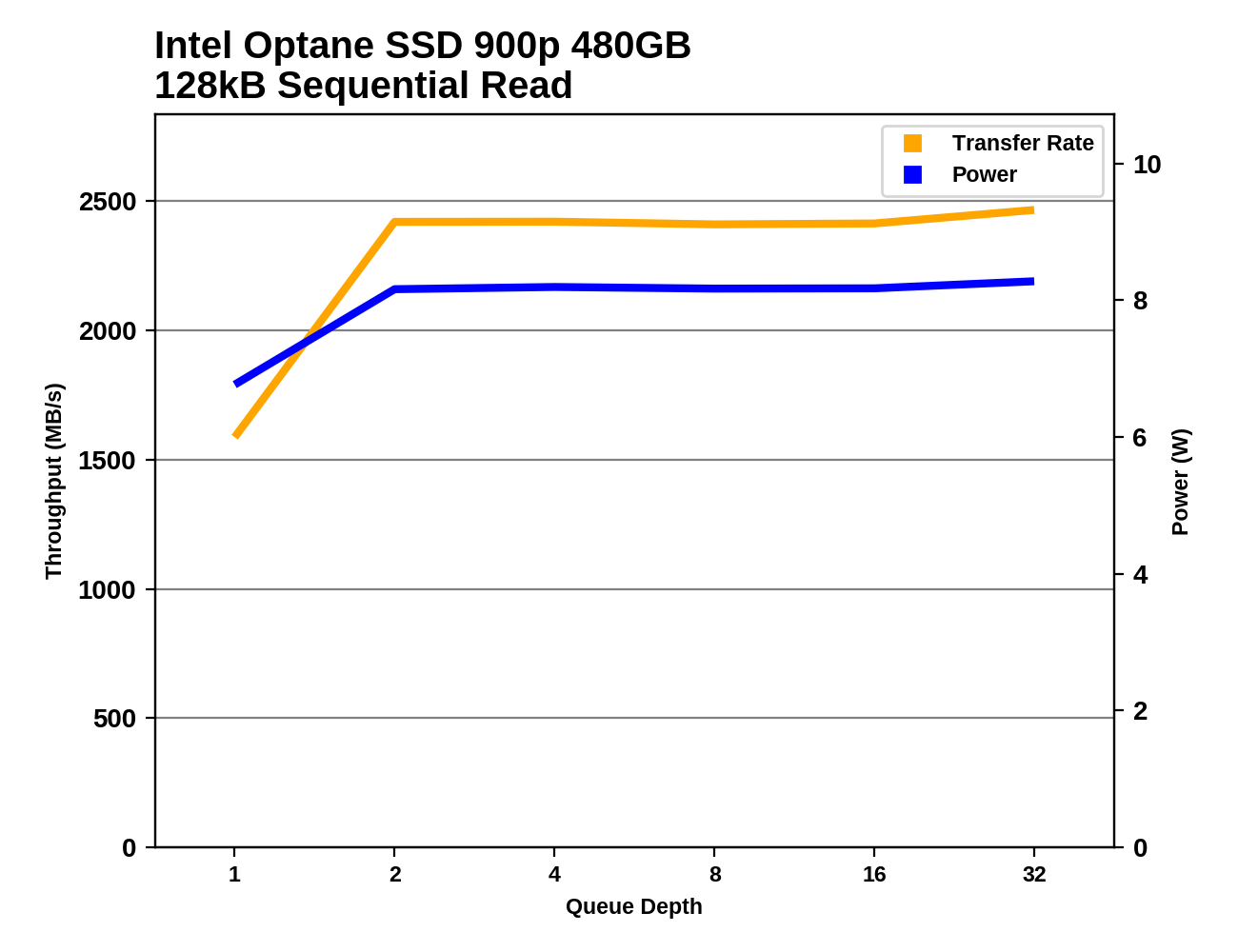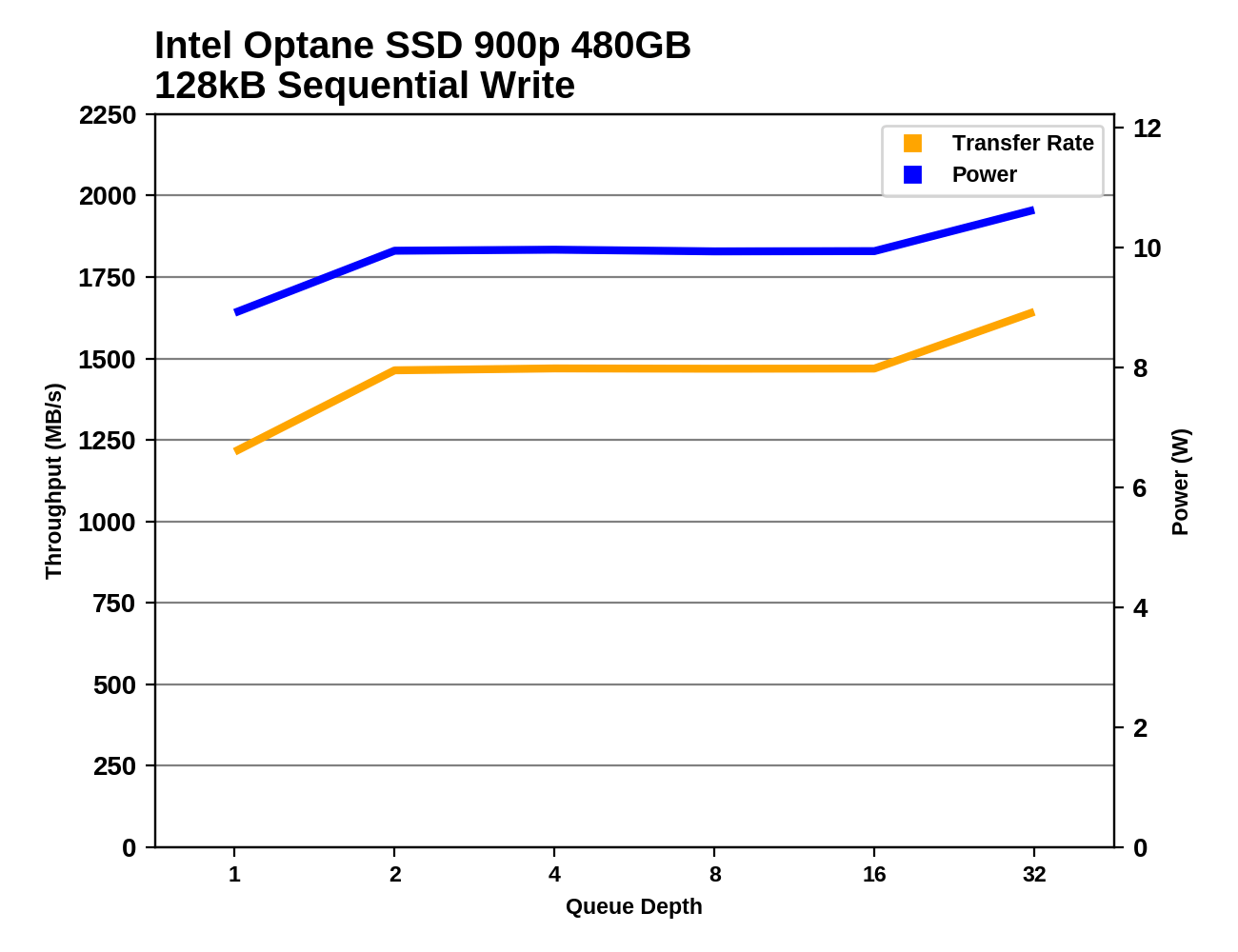The Intel Optane SSD 900p 480GB Review: Diving Deeper Into 3D XPoint
by Billy Tallis on December 15, 2017 12:15 PM ESTSequential Read Performance
Our first test of sequential read performance uses short bursts of 128MB, issued as 128kB operations with no queuing. The test averages performance across eight bursts for a total of 1GB of data transferred from a drive containing 16GB of data. Between each burst the drive is given enough idle time to keep the overall duty cycle at 20%.

Despite having incredibly low access latency, the Optane SSD 900p doesn't beat the fastest flash-based SSDs in our burst sequential read test. The fastest flash SSDs make up for their slower initial response time through a combination of higher channel counts, prefetching and most likely larger native block sizes. The Optane SSD 900p still has a great score here, but it fails to stand out from the much cheaper flash-based drives.
Our test of sustained sequential reads uses queue depths from 1 to 32, with the performance and power scores computed as the average of QD1, QD2 and QD4. Each queue depth is tested for up to one minute or 32GB transferred, from a drive containing 64GB of data.

With the test of higher queue depths and longer run times, the Optane SSDs are back on top with a substantial performance lead. Unlike the burst test, this test shows almost no performance difference between the two capacities of the Optane SSD 900p.

The performance lead of the Optane SSD 900p isn't enough to make up for its higher power consumption, so the 900p ends up in the second tier of drives for sequential read power efficiency, alongside Samsung's 960 generation and the Toshiba XG5.
 |
|||||||||
The 480GB Optane SSD 900p draws about 0.6–0.75W more than the 280GB model during the sequential read test, putting it just over 8W total when operating at full speed. Even the smaller 900p is still over 6W at QD1, while the flash-based SSDs are mostly in the 4-5W range. (The Intel SSD 750 breaks 9W at higher queue depths.)
Sequential Write Performance
Our test of sequential write burst performance is structured identically to the sequential read burst performance test save for the direction of the data transfer. Each burst writes 128MB as 128kB operations issued at QD1, for a total of 1GB of data written to a drive containing 16GB of data.

The burst sequential write performance of the Intel Optane SSD 900p is on par with some of Samsung's older NVMe SSDs, but is exceeded by the 960 generation and the PM981.
Our test of sustained sequential writes is structured identically to our sustained sequential read test, save for the direction of the data transfers. Queue depths range from 1 to 32 and each queue depth is tested for up to one minute or 32GB, followed by up to one minute of idle time for the drive to cool off and perform garbage collection. The test is confined to a 64GB span of the drive.

On the longer sequential write test, the Samsung PM981 falls out of first place and ends up substantially slower than the Optane SSD 900p, but the Samsung 960 PRO and EVO are still faster than the 900p.

The power efficiency of the Optane SSD 900p during sequential writes is worse than most M.2 NVMe SSDs, though not as bad as the extremely power-hungry Intel SSD 750.
 |
|||||||||
The two capacities of the Optane SSD 900p offer essentially identical sequential write performance. As with sequential reads, the difference in power consumption between the two capacities is about 0.75W, but the writes require about than 2W more than the reads.










69 Comments
View All Comments
Notmyusualid - Sunday, December 17, 2017 - link
So, when you are at gun point, in a corner, you finally concede defeat?I think you need professional help.
tuxRoller - Friday, December 15, 2017 - link
If you are staying with a single thread submission model Windows may we'll have a decent sized advantage with both iocp and rio. Linux kernel aio is just such a crap shoot that it's really only useful if you run big databases and you set it up properly.IntelUser2000 - Friday, December 15, 2017 - link
"Lower power consumption will require serious performance compromises.Don't hold your breath for a M.2 version of the 900p, or anything with performance close to the 900p. Future Optane products will require different controllers in order to offer significantly different performance characteristics"
Not necessarily. Optane Memory devices show the random performance is on par with the 900P. It's the sequential throughput that limits top-end performance.
While its plausible the load power consumption might be impacted by performance, not always true for idle. The power consumption in idle can be cut significantly(to 10's of mW levels) by using a new controller. It's reasonable to assume the 900P uses the controller derived from the 750, which is also power hungry.
p1esk - Friday, December 15, 2017 - link
Wait, I don't get it: the operation is much simpler than flash (no garbage collection, no caching, etc), so the controller should be simpler. Then why does it consume more power?IntelUser2000 - Friday, December 15, 2017 - link
You are still confusing load power consumption with idle power consumption. What you said makes sense for load, when its active. Not for idle.Optane Memory devices having 1/3rd the idle power demonstrates its due to the controller. They likely wanted something with short TTM, so they chose whatever controller they had and retrofitted it.
rahvin - Friday, December 15, 2017 - link
Optane's very nature as a heat based phase change material is always going to result in higher power use than NAND because it's always going to take more energy to heat a material up than it would to create a magnetic or electric field.tuxRoller - Saturday, December 16, 2017 - link
That same nature also means that it will require less energy per reset as the process node shrinks (roughly e~1/F).In general, pcm is a much more amenable to process scaling than nand.
CheapSushi - Friday, December 15, 2017 - link
Keep in mind a big part of the sequential throughput limit is the fact that the Optane M.2s are x2 PCIe lanes. This AIC is x4. Most NAND M.2 sticks are x4 as well.twotwotwo - Friday, December 15, 2017 - link
I'm curious whether it's possible to get more IOPS doing random 512B reads, since that's the sector size this advertises.When the description of the memory tech itself came out, bit addressability--not having to read any minimum block size--was a selling point. But it may be that the controller isn't actually capable of reading any more 512B blocks/s than 4KB ones, even if the memory and the bus could handle it.
I don't think any additional IOPS you get from smaller reads would help most existing apps, but if you were, say, writing a database you wanted to run well on this stuff, it'd be interesting to know that small reads help.
tuxRoller - Friday, December 15, 2017 - link
Those latencies seem pretty high. Was this with Linux or Windows? The table on page one indicates both were used.Can you run a few of these tests against a loop mounted ram block device? I'm curious to see what both the min, average and standard deviation values of latency look like when the block layer is involved.